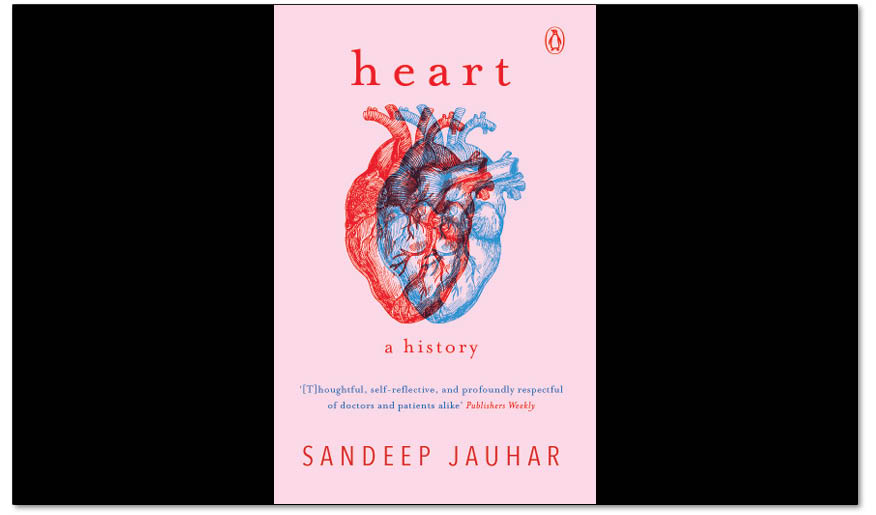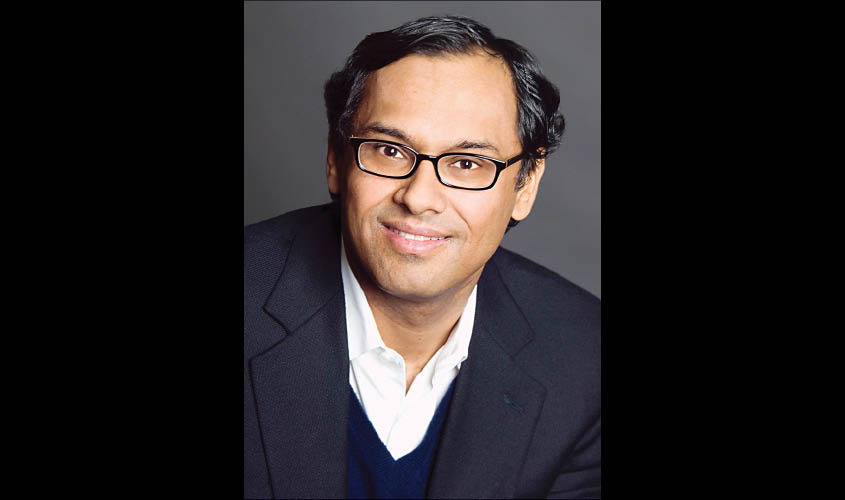In his book Heart: A History, author and cardiologist Sandeep Jauhar looks back at how philosophers and physicians across the ages have attempted to understand the human heart.
This book is about what the heart is, how it has been handled by medicine, and how we can most wisely live with—as well as by— our hearts in the future. The heart’s vital importance to our self-understanding is no accident. If the heart is the last major organ to stop working, it is also the first to develop— starting to beat approximately three weeks into fetal life, even before there is blood to pump. From birth until death, it beats nearly three billion times. The amount of work it performs is mind- boggling. Each heartbeat generates enough force to circulate blood through approximately 100,000 miles of vessels. The amount of blood that passes through an average adult heart in a week could fill a backyard swimming pool. But the life that it sustains can quickly be taken away. When the heart stops, death is instantaneous. If life is a continuous struggle against the inexorable march of entropy, then the heartbeat is at the core of that conflict. By purveying energy to our cells, it counteracts our tendency toward dissipation and disarray.
More than anything, the heart wants to beat; this purpose is built into its very structure. Heart cells grown in a petri dish start to contract spontaneously, seeking out other cells (through electrical connections called gap junctions) to synchronise in their rhythmic dance. In this sense, cardiac cells— and the organ they create— are social entities. The heart can continue to beat for days, even weeks, after an animal has died. In a laboratory, the French Nobel laureate Alexis Carrel showed that properly nourished chick heart tissue cultured on a medium of blood plasma and water will pulsate for months and can remain alive for more than twenty years, much longer than the normal life span of its host. This is a unique property of the heart. The brain and other vital organs cannot function without a beating heart, but a beating heart does not depend on a functioning brain, at least not in the short term. Moreover, the heart doesn’t just pump blood to other organs; it pumps blood to itself. We cannot see our own eyes. We must struggle to use our minds to change our way of thinking. But the heart is different. In a sense, and unlike any other organ, the heart is self-sustaining.
Of all the connections of the heart—to emotions, to thought—the link between the heartbeat and life is perhaps the strongest. We associate the heart with life because, like life itself, the heart is dynamic. From second to second, and on a macroscopic scale, the heart is the only organ that discernibly moves. Through its murmurings, it speaks to us; through its synchronised contractions, it broadcasts an electrical signal several thousand times more powerful than any other in the body. Over the centuries, disparate cultures have viewed the heart as the source of a life- giving force that was to be culled or harvested. In ancient Egypt, the heart was the only organ that was left in the body during mummification because it was believed to play a central role in the rebirth of an individual after death. In a scene often depicted in Egyptian mythology, the heart of a deceased person is weighed on a scale balanced by a feather or statuette representing truth and divine law. If the heart balanced evenly, it was considered pure and returned to its owner. But if it proved laden with sin, it was devoured by a monstrous chimera, and the deceased was banished to the underworld. Three thousand years later, in elaborate hilltop ceremonies, the Aztecs opened the chests of slaves with flint knives and ripped out their still-beating hearts as offerings to their idols. In Western fairy tales, witches seeking immortality consumed the hearts of innocents. In Snow White, for example, the evil queen insists the hunter cut out the girl’s heart to ensure that she is really dead. Even today, when brain death has become a widely accepted sign of demise, people continue to associate a heartbeat with viability. Families come up to me in the intensive care unit and say, “His heart is beating. How could he be dead?”

By Sandeep Jauhar; Publisher: Penguin Random House; Pages: 288; Price: Rs 599
The sanguine dance must eventually come to an end. Cardiovascular disease claims 18 million lives—nearly one-third of all deaths—across the globe each year. Since 1910, heart disease has been the number one killer in the United States. Today 62 million Americans (and more than 400 million worldwide, including 7 million in the United Kingdom) suffer from heart disease.
The second most common cause of death in America is cancer, but heart disease and cancer could hardly be more different. In cancer, cells divide madly, migrate wildly, invade mercilessly, in a sort of hard-charging pollution of the body. Heart disease is different: cleaner, stricter, less ambiguous, more comprehensible. Cancer patients, Susan Sontag wrote, are stained and fragmented. Cardiac patients, she said, often stand tall, seemingly healthy, like my grandfather, until they die.
The numbers could be even worse. Cardiovascular deaths in America have actually declined by almost 60% since the mid-1960s. From 1970 to 2000, the average life span in the United States increased by six years. Two- thirds of this increase in longevity came from advances in cardiovascular treatments. (In recent years there has been decreasing life span in middle-aged whites for non- cardiovascular reasons.) Although more than 60% of Americans will develop some form of cardiovascular disease in their lifetime, less than a third will die of it, so we know our treatments are effective. The twentieth century will go down in history as one in which the great scourge of cardiovascular disease finally began to come under control.
The cardiovascular situation in America is likely going to get worse in the coming years. Adherence to a heart- healthy lifestyle has decreased. In aggregate, Americans have become more obese and sedentary, and smoking rates have hardly changed in the past two decades. An autopsy study in the Archives of Internal Medicine suggests that 80% of Americans sixteen to sixty- four years old have at least the beginnings of coronary artery disease. These findings indicate that the four decade-long decline in heart disease may be coming to a screeching halt. We will need new ways to cope with this threat.
In the pages that follow, I will examine the emotional and scientific dimensions of an organ that has intrigued and eluded philosophers and physicians for centuries. No other organ—perhaps no other object in human life—is so imbued with metaphor and meaning. The history I will describe is not one of uninterrupted progress, but it is one that, in fits and starts, has solved major challenges, helping countless people survive a disease that was once considered terminal. It is a grand story—from the natural philosophers who dwelled on the heart’s metaphorical meanings, to William Harvey and the discovery of circulation, to large-scale endeavors like the Framingham Heart Study that explored the causes of heart disease, to modern surgical techniques and technologies that even a century ago, because of the heart’s exalted status in human culture, were considered taboo.
Extracted with permission from ‘Heart: A History’, written by Sandeep Jauhar, published by Penguin Random House

